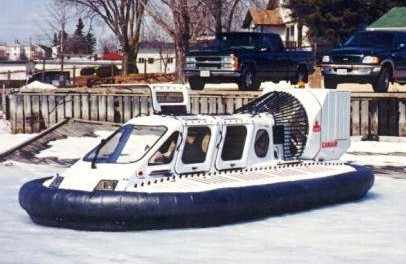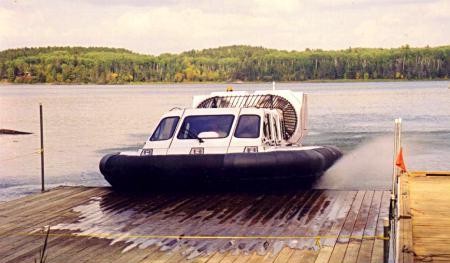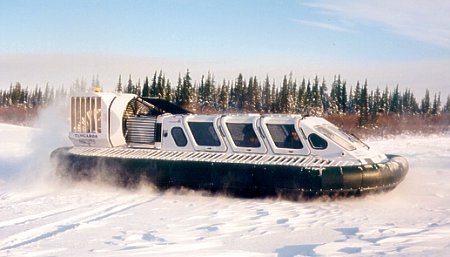Canair Hovercraft Inc.
Canair 506 / 509 / 512
Canair Hovercraft was the brainchild of Ron Fishlock.
It was the natural development of Ron's hovercraft career since coming to Canada
in the early 1970's. The concepts behind the Canair series evolved from
his earlier projects with the Canair 2 and Canair
440.

The Canair 506 on the ice.
The Canair 506 6-seat hovercraft was powered by a Cam 100
engine
driving a 12-blade multi-wing fan via an integral gear reduction unit and toothed
belt. The skirt was an HDL loop-segment type with a unique attachment which
minimises the possibilities of the segment snagging on obstacles. The hull
was comprised of modular components each constructed of fibreglass over a closed
cell foam core. Precise control of all Canair hovercraft was achieved through a
single control column. Pushing the column forward directed thrust air aft
pushing the machine forward. Lean it to the left and the hovercraft turned
left. Pull it back and the craft would brake. Leave it back and the
craft would reverse. Steering control was maintained while
the hovercraft reversed. The 506 - the first machine developed by Canair - was the
"baby brother" of the Canair line.
Canair 506 Specifications
Length: 19'11"/6.1 m Width: 8'3"/2.51
m Height: 6'1"/1.85 m Gross Weight 2911
lbs/1320 kgs
Payload: 1105 lbs/502 kgs Fuel Cap: 24 gal
(US) Cruise Speed: 35 mph Hover height:
12"

Canair's 509 coming up a boat ramp
Constructed using the same modules as the Canair 506, the 509
seated 9-passengers and was powered by twin Cam-100's each driving its own
12-bladed multi-wing fan.
Canair 509 Specifications
Length: 19'11"/6.1 m Width:
11'11"/3.63 m Towing Width: 8'9"/2.69
m Height: 6'4"/1.92 m
Gross Weight: 4290 lbs/1946 kgs Payload: 1710 lbs/777 kgs
Fuel cap: 48 gal (US) Cruise speed: 38 mph

The Canair 512 operating over snow.
The Canair 512 was the largest hovercraft produced by Canair.
Like its little brother, the 509, it was powered by twin Cam 100 engines.
Each of these drove a 12-blade multiwing fan via an integral gear reduction unit
and toothed belt. The 512 could operate for over 4-hours at its maximum
gross weight at high cruise. Its cruise speed on light choppy water was
said to be 36 MPH / 58 kph.
Canair 512 Specifications
Length: 22'10"/6.96
m Width: 11'11"/3.63
m Towing Width 8'9"/2.69 m Height:
6'4"/1.92 m
Gross Weight: 5334 lbs/2420 kgs Payload 2460 lbs/1119 kgs
In
August of 2000 Canair Hovercraft Inc. folded. The letter to shareholders and
creditors was brief and terse:
"Dear Sir/Madam: Regrettably, I must advise you that
the company has ceased operations." It went on to explain
that the assets and intellectual property had been seized
for sale in an attempt to repay outstanding loans, with
secured creditors to be paid first. Citing insufficient financial
resources to continue, it further advised that employees (employment)
had been terminated and the company premises
surrendered to the landlord. And so another Canadian
hovercraft company closed its doors after 12
short years, with a product family which, in many ways,
set a new standard for control and visual appeal in the
light commercial hovercraft market.
In
its 12 year life, Canair moved four times: from the Fishlock
workshop, where many of the hull plugs and molds
were built; to a building in the Carleton Place Industrial Park;
then to a shared industrial unit with Canwest Hovercraft
in Langley, BC; then to its own facility in Langley
where the first two twin engine craft were built; and
finally, to a larger facility in Langley with the potential to
house series production.
In
all, a total of 16 hovercraft were built: eight model 506s,
one model 509 and seven model 512s. These craft have found
work in a wide variety of locales, with the 506s currently located
in Surrey, BC; Niles, Ohio; two in Big Pine Key, Florida; Chetwynd, BC;
Watertown, New York; London, Ontario;
and Tighnish, PEI. The 509 is located in Sioux
Narrows, Ontario, while the 512s are in Italy (heading
for Curacao – Netherlands Antilles); Nain, Labrador;
Washburn, Wisconsin; Island Lake, Manitoba; two
craft in Long Beach, California; and one in Churchill, Manitoba.
In terms of usage, four of the craft are considered as
personal use, five are used as freighters, with two of
those doubling as MEDEVAC ambulances, and seven being
used for tourism.
The Canair series was manufactured by:
Canair Hovercraft Inc.
Unit 111
20351 Duncan Way
Langley, British Columbia
V3A 7N3
Telephone: (604) 514-3297
|
